#history of martial arts
Explore tagged Tumblr posts
Text

"CAUGHT A TARTAR," Vancouver Sun. June 13, 1934. Page 1. --- 2 Thugs Pick on Wrong Victim - Jiu Jitsu Expert Gives Lesson ---- NEW WESTMINSTER, June 13. -Two husky thugs who attacked W. Sonderman, a member of the crew of the S.S. Pacific Pioneer, on the Pacific Coast Terminals Co., dock at 9 o'clock Tuesday night, are probably still wondering who called out the army.
Sonderman reported to police to-day that while walking on the dock he was accosted by two men who asked him for money. When he refused their demands, one of them seized him while the other started searching his pockets.
Before they got properly started in their nefarious undertaking, Sonderman, who is a jiu jitsu expert, commenced using his scientific knowledge in a most disconcerting manner.
Sonderman threw both men heavily and became the aggressor.
With loud yells of surprise and pain the two bandits, fled leaving the victor alone on the dock.
Sonderman stated that he has won several cups and medals for jiu jitsu and it was a simple matter to handle the two thugs.
Both men were described as about five feet 11 inches tall, huskily built and about 30 years of age.
#vancouver#new westminster#armed self defence#martial arts#jiu jitsu#history of martial arts#canadian sailors#attempted robbery#muggers#great depression in canada#crime and punishment in canada#history of crime and punishment in canada
0 notes
Text
When does punchy punchy beat stabby stabby?
(Other than rock paper scissors)
Please consider supporting me on Patreon!
3K notes
·
View notes
Text
While Elvis is widely recognized as 'The King' in the world of entertainment—in the dojo, he’s referred to as Mr. Tiger. He began training under the renowned, Master Kang Rhee at the Tennessee Karate Institute in 1970 where he earned his 8th degree black belt.









(enjoyed the post? follow @curatethe.wav for more 📟) 👇 👇 👇 👇 👇 👇 👇 👇 👇 👇 👇 👇 👇 👇 👇 👇
https://www.instagram.com/share/BBqF6sDAyz
#elvis presley#Elvis#elvis history#archive page#curatethewav#explore page#explore#moodboard#awge#fypシ゚viral#tumblr fyp#modernnotoriety#1974#1970#70s elvis#70s#70s music#karate#black belt#tennessee#Tennessee karate institute#martial arts#new gladiator a#tiger#Mr tiger#mrtiger#elvis fans#60s elvis#elvis the pelvis#hound dog
92 notes
·
View notes
Text


"Brawl Busters" (1978) was a martial arts film that was advertised as being from the "Chinese Black Belt Society" in an opening card. Not only does this group not exist, the movie isn't even Chinese, but Korean. It was common for a lot of Korean films of this era to be set in China and have a Hong Kong cast. The film also was said to star "Black Jack Chan," who not only was not in the film, but also doesn't exist at all. As the images above show, it is a female led martial arts film.

This deeply strange credit to a made up Kung Fu Society and a claim to star a completely made up Chinese leading man was because, as surprising as it is to consider today, there was a time when it was extremely rare to have any entertainment come out of South Korea, and the producers figured it would have a bigger audience in Asia if this film was thought to be from Hong Kong. If it was known to be Korean, it would come off as a knockoff, which, to be fair, it completely was. South Korea was under military rule until the 1980s, and nearly all of its early entertainment industry was based on the blueprint of the cultural capital of Asia in the 70s-80s, Hong Kong, like Hitman in the Hand of Buddha, Woman Avenger (a Korean version of the very Chinese story of Wing Chun, famously played a decade later by Michelle Yeoh). Korean films of this era had many Hong Kong stars like Angela Mao, who made Hapkido and When Taekwondo Strikes in the early 70s there as joint Korean/Chinese productions. It also went both ways: many Korean talent in this era had to emigrate Korea to get into showbusiness, like "Thunderfoot" Hwang Jang Lee. After all...who ever heard of getting famous in entertainment in South Korea, anyway?

188 notes
·
View notes
Text

75 notes
·
View notes
Text

July 2nd, 1812: the start of U.S. General William Hull's terrible, horrible, no good, very bad day!
Unaware that war had been declared, Hull sent the American-flagged schooner Cuyahoga Packet up the Detroit River past the British fort at Amherstburg carrying musicians with instruments, invalid soldiers, and his personal baggage of journals, top-secret military plans, and correspondence with Secretary of War William Eustis.
Cuyahoga Packet was promptly captured by armed men in a British longboat who informed the surprised Americans of their situation, and forced the musicians to play "God Save the King." (Then they sent the war plans to General Brock).
#war of 1812#military history#age of sail#cuyahoga packet#detroit#william hull#us history#canadian history#art by#peter rindlisbacher#1810s#this isn't even what got hull court martialed (that would be the surrender of detroit)
87 notes
·
View notes
Text

Capoeira, Salvador, Bahia, Brazil, 1946-1959.
Photographer: Pierre Verger
131 notes
·
View notes
Text
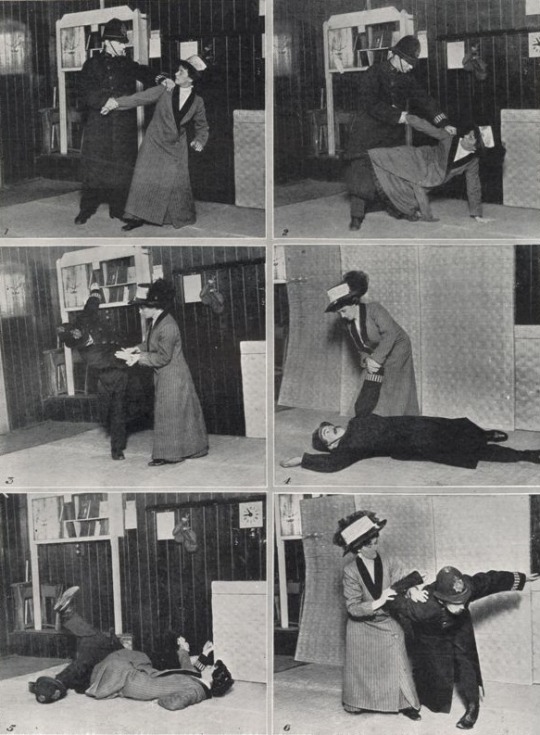
Edith Garrud - The suffragette that knew martial arts
The first British female teacher of jujutsu, Edith Garrud (1872-1971) taught the suffragettes to protect themselves.
A passion for martial arts
Edith Margaret Williams was born in Bath in 1872 and started her career as a physical instructor for girls. She shared this passion for physical culture with her husband, William Garrud, a wrestling and boxing instructor.
They came in contact with Edward Barton-Wright who had spent three years in Japan, and studied judo and jujutsu. He elaborated his self-defense techniques known as “bartitsu” and opened his club in London in 1899.
The Bartitsu Club was notably opened to women. Edith was thus able to train alongside her husband. By 1908, Edith and William became jujutsu instructors themselves with William in charge of the men’s class and Edith teaching the women and children.
Jujutsu specializes in speed, precision and the use of soft, flowing movements to deal with aggression rather than using just brute strength. The couple showcased their skills through demonstrations. In one of them, Edith defeated a male aggressor played by her husband. The sight of this 4ft-11inch (150cm) woman effortlessly throwing a much taller man greatly impressed the audience.
In 1907, Edith starred in a short film Jujutsu down the footpads in which an innocent lady overpowers two ruffians.
Vote for women
Edith took an interest in the cause of women’s suffrage. In 1909, she was invited by the Women's Social and Political Union (WSPU) to give a demonstration in the presence of Emeline Pankhurst and other leading figures of the movement. As William was ill, Edith demonstrated alone and invited members of the audience to test her skills. This included subjecting a skeptical police officer to a powerful shoulder throw.
In 1910, Edith also wrote a series of essays, advocating for the growing community of female martial artists and how self-defense could free women by giving them the means to protect themselves:
“You constantly read in the papers reports of dastardly attacks on helpless women by thieves and ruffians. A woman who knows jujutsu, even though she may not be physically strong, even though she may not have even an umbrella or parasol, is not helpless. I know many women personally who have tried the tricks I shall explain to you and come out on top. They have brought great burly cowards nearly twice their size to their feet and made them howl for mercy.”
The bodyguards
The suffragettes faced dangerous and violent situations. This was especially the case on Friday 18th November 1910. 300 WSPU members marched on the House of Parliament and faced police officers armed with batons. Women were subjected to six hours of beatings and arrests and there were widespread reports of sexual abuses.
Emeline Pankhurst thus asked Edith to train a group of women that would be known within the WSPU as the Bodyguard. Led by Gertrude Harding, they acted as agitators, disruptors and decoys.
Edith trained them in hand-to-hand combat and the use of homemade concealed weapons such as wooden India clubs and the fashioning of cardboard body armor. The suffragettes took advantage of their opponent's surprise and exploited their weaknesses.
They for instance struck directly at a police officer’s helmet to knock it from his head. Policemen were held accountable for the loss of uniform items and had to pay for their replacement. They cut the suspenders so that the policeman had to hold back his pants, blinded the police with a charge of umbrellas etc.
When told by a policeman that she was making an “obstruction” during a demonstration near the House of Commons, Edith pretended to drop her handkerchief, threw the policeman over her shoulder and disappeared into the crowd.
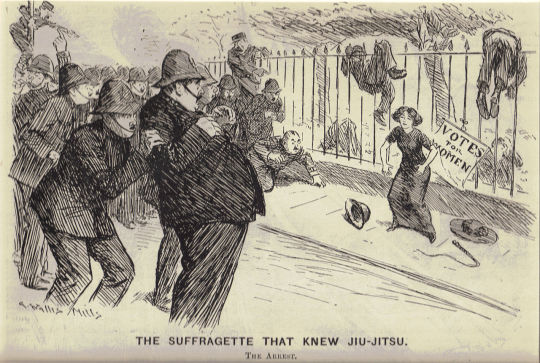
In prison, suffragettes went on hunger strikes and were subjected to force-feeding. The “Cat and Mouse Act” of 1913 allowed hunger-striking prisoners to be released and then re-incarcerated as soon as they had recovered their health. The Bodyguard thus protected and hid those women.
Edith for instance hid militant suffragettes in her dojo, telling the police not to disturb her lessons and leave her property.
A quiet retirement
Edith’s contributions to the suffragist movement ended with the beginning of the First World War. Little is known of her life afterward.
She and her husband would run the Golden Square dojo until their retirement in 1925 and retired to a quieter life. William passed away in 1960. In an interview in 1965, Edith said that her recipe for a long, happy and healthy life was:
“Self-discipline. Of course, I had to be extremely disciplined to succeed at jujutsu and hold my own with men […] but it is the mind which really has control, not only of your muscles and your limbs and how you use them, but also your thoughts, your whole attitude to life and other people.”
She died in 1971. A plaque on the building that had been her home can be seen today: “Edith Garrud 1872–1971. The suffragette who knew jiu-jitsu lived here”.
Further reading
Dorlin Elsa, Se défendre : une philosophie de la violence
Godfrey Emelyne, Femininity, Crime and Self-Defence in Victorian Literature and Society: From Dagger-Fans to Suffragettes
Kelly Simon, "Edith Garrud: The jujutsuffragette". In McMurray, Robert; Pullen, Allison (eds.), Power, Politics and Exclusion in Organization and Management
Ruz Camila, Parkinson Justin, ““'Suffrajitsu': How the suffragettes fought back using martial arts”
#history#women in history#women's history#feminism#suffragettes#20th century#edith garrud#martial arts#jujutsu#jiujitsu#england#english history#herstory#women in martial arts#historical figures
116 notes
·
View notes
Text
The Black Karate Federation (BKF)
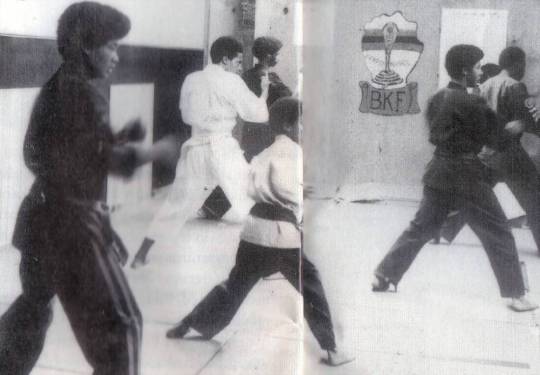
The Black Karate Federation (BKF) emerged as a response to the events surrounding a pivotal tournament held in 1969, which featured a match between two prominent martial artists, Joe Lewis and Sijo Muhammad, who was then known as Steve Sanders. The establishment of the BKF was motivated by a desire to address issues of unequal opportunity and representation within the tournament circuit, particularly for African-Americans, Hispanics, and other minorities.
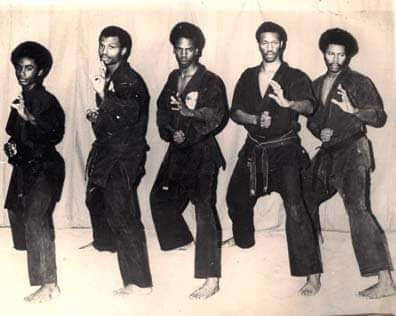
The BKF aimed to level the playing field by providing a platform that offered equal opportunities for martial artists from underrepresented backgrounds to showcase their skills and compete on a fair and inclusive basis. In doing so, it sought to break down the barriers and biases that had historically hindered the progress of minority practitioners in the martial arts community.
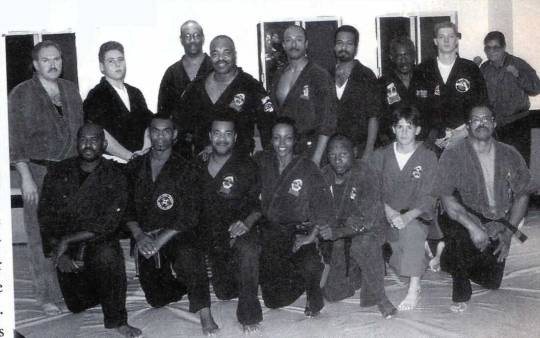
One of the significant contributions of the BKF was its commitment to fostering the growth and development of young people through martial arts. Recognizing the transformative power of martial arts training, the organization offered karate lessons to young individuals who may not have had the financial means to afford such opportunities. This initiative not only provided access to valuable self-defense skills but also promoted discipline, self-confidence, and personal growth among the youth, particularly in underserved communities.
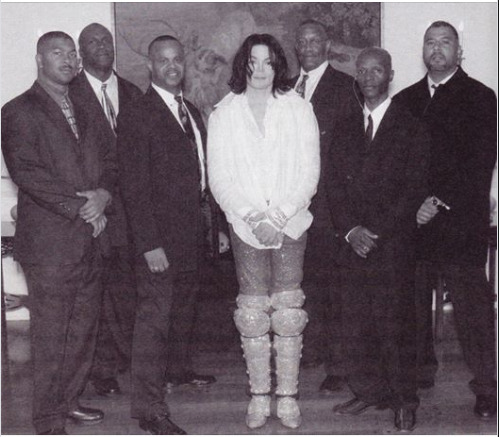
"Our mission is to create a greater sense of awareness of both physical and mental health, to assist individuals, including at risk youth, in reaching their potential and expanding their social consciousness by establishing goals, building confidence and developing a strong self concept."
youtube
174 notes
·
View notes
Text
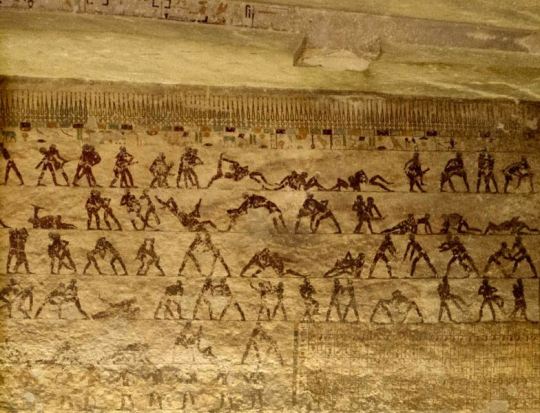



A mural depicting ancient Egyptian grappling techniques, found in the tomb of Baquet III, an Egyptian high official who lived around 2000 BC and must have really liked wrastlin'
687 notes
·
View notes
Text
An interesting background detail implied but not exactly explicitly stated is that there is a tradition of open hand martial arts in Altazia. The way that Taiven has a sparring dummy even though she's a mage with a weapon, the poses that she has in the art, it points to some type of unarmed technique. "Well no shit sherlock, why bring it up?" I wanted to establish this because in most dialogue, her comments of knowing how to fight and physical fitness could be interpreted as her talking about using weapons in combat. And I wanted to establish that because I was trying to figure something out. Why is there an unarmed tradition in a world of mages? Martial arts are not born in a vacuum. Willingly deciding to train how to fight without a weapon instead of with one is usually done with other factors involved. Sure, most cultures in our world developed some type of unarmed combat, but most of the time it devolves into some type of sport overtime (like boxing and wrestling now) as weapons prove more and more effective (from what I understand). What usually kept unarmed martial arts alive for serious self defense is either a) a population that can't afford weapons or b) an oppressive government that bans weapons to disempower resistance (this is based on my limited understanding, I know there are gaps in it). I know that Okinawan Karate became as strong of a tradition as it did because Japan banned Okinawans from owning weapons and they had to find a way to defend themselves without them (some people argued this was with the goal of fighting in a secret resistance with guerrilla tactics but that's been heavily disputed). So, in the MoL world, why would weapons be banned? How useful would unarmed combat be in a world where organizations that can ban weapons can also have mages? Because unlike having a weapon, magic can be taught to any one, and probably be much more effective. I can personally only think of three reasons why. 1) Mages were much less common than they seem to be in modern day Altazia. Fighting other people with weapons when you didn't have any was still viable and learning magic from anyone at all (including non-giant power structures like witches and tribes) wasn't viable for most. 2) Weapons were important to mages, as it was hinted in the gods' boons to mortals magical artifacts and weapons were used to push back against the frontier. This suggests a significant portion of magic use was done through objects and weapons, and the banning of it meant that people had to learn how to cast without those objects and fight without them at the same time. (Of course overtime spellcasting without weapons/objects were adopted by everyone as all superior spellcasting does, and as the spellcasting tradition was separated from the martial art, all that was left was the physical techniques). 3) Martial arts aren't a method of self defense at all and are only regarded as a sport. Only useful for exercise, and most importantly, cements Taiven's character as a jock official as she is the coach's assistant to teach the sport and has dummies to practice at home.
#mother of learning#taiven#just had some thoughts on martial arts I wanted to share#because I find this kind of worldbuilding and history very interesting
40 notes
·
View notes
Text




Bloodsport of the Scrub Tortoises.
Tortoise boxing, the oldest documented martial art, was first referenced in the 5th century as a method of self-defense. It survives and is still practiced today, from prize fighting to special forces training!
Source: art compiled by martial historian Dusty Diamond
Frogiverse.com
#archaeology#history#art history#ancient artifacts#artifacts#tortoise#martial arts#mma#boxing#educational#worldbuilding#ufc#fighting#critters#animals#nature#fantasy#martialarts
105 notes
·
View notes
Text
On December 23, 1994, Street Fighter debuted in the United States.

Here's some new Raul Julia art!
#street fighter#steven e desouza#raul julia#action movies#action film#1990s#90s movies#fan art#movies#movie art#action comedy#martial arts film#video game movies#cult cinema#90s action movies#midnighht movies#cult film#cult movies#art#drawing#movie history#pop art#modern art#pop surrealism#portrait
9 notes
·
View notes
Text
a bit of fighting i did at a small games convention two weeks back
i’m in the polished 3/4s armour with the blue trunkhose
#fantasy#medieval#16th century#historical european martial arts#hema#armour#harnischfechten#longsword#pollaxe#event#reenactment#living history#larp
44 notes
·
View notes
Text
Dandadan chapter 177 (cont.1)
Previous post contains spoilers~ -> Chapter 177
So I just had my first semester test done 2/5, 3 more to go and I can rest for the holiday (aka New Year 2025)
So I found this very cool post on Facebook VN (click link) about the latest chapter!
This Arc probably gonna be something very Chinese~
I mean, look at it! We have jiangshi, iron ox, yin-yang...

So apparently, it seems that the type of martial arts that Seiko-obachan used when fighting the jiangshi (Chinese vampire-like zombies) (I mentined this in chapter 177 post) is Eight Extreme Fist [Vietnamese: Bát Cực Quyền (Khai môn bát cực quyền) or Chinese: 八極拳 (開門八極拳), pinyin: Bājíquán (Kāimén bā jí quán) or Japanese: Hakkyokuken/ Hakka Kuen)
More details if you are interested: (from wiki)
Bajiquan (Chinese: 八極拳; pinyin: Bājíquán) is a traditional Chinese martial art that features explosive, short-range power in close combat and is well-known for its rapid elbow and shoulder strikes. Its full name is kaimen bajiquan (Chinese: 開門八極拳; pinyin: Kāimén bājíquán; lit. 'open-gate eight-extremities boxing'). The eight extremities in Bajiquan refers to the eight distalmost parts of the body to strike the opponent. This includes the fist, forearm, elbow, shoulder, hip, thigh, knee, and foot to deliver a powerful blow in close range. Bajiquan is also known as the "bodyguard style", as this was the pugilism style taught and used by personal bodyguards for Mao Zedong, Chiang Kai-shek, and Puyi (the last Qing dynasty emperor). Bajiquan is now popular in northern China and Taiwan. Later, it was introduced to Japan, South Korea, and other countries; such as the United States, Canada, Britain, France, Italy, among others.
Now I'll explain the word "Bát cực quyền" for you! (Sino-Vietamese)
bát means tám (8) -> Eight
cực means super, extreme -> Extreme
quyền means đòn, like attack and defense using hands, so basically hands movements, usually fists -> Fist
-> so now you know: Eight Extreme Fist
And for Japanese (Romanji) (it's the same) (from wiki): Hakkyokuken is a style that emphasized strong striking power. All powers are generated from legs and feet. It is widely used by the security guards in Taiwan and China.
#ダンダダン#dan da dan#seiko ayase#ayase seiko#jiangshi#yin and yang#chinese#explained#interesting facts#facts#fun facts#random facts#truth#reality#knowledge#history#vietnamese#past#documentary#martial arts#bajiquan#eight extreme fist#facebook#information#useful#informative#links#resources#helpful#spring 2025
9 notes
·
View notes
Text

33 notes
·
View notes